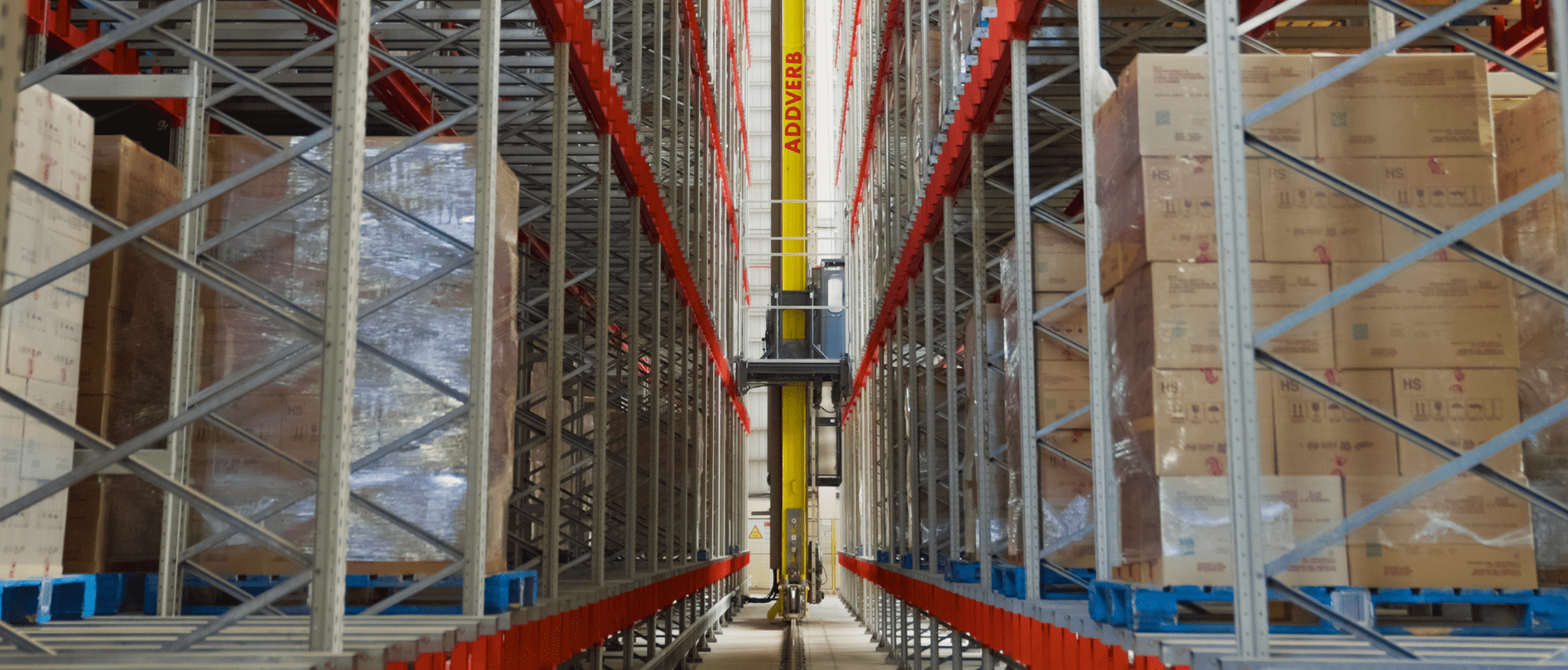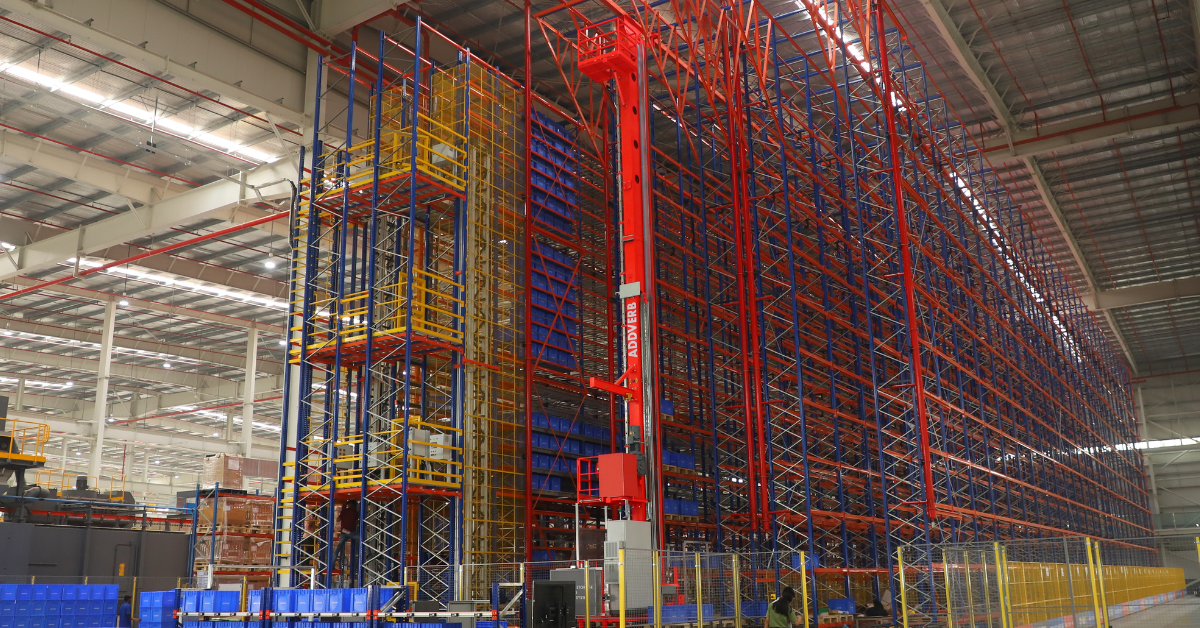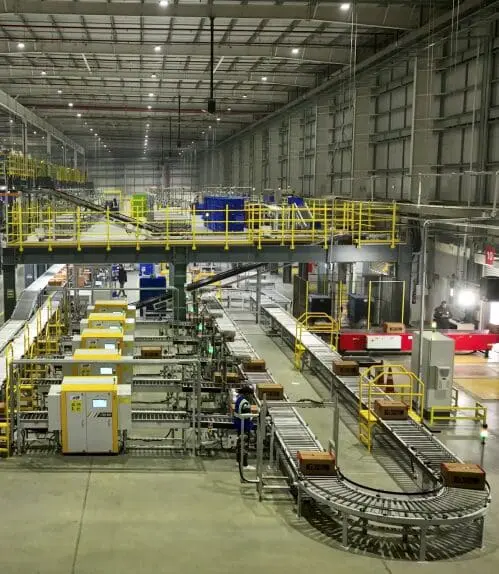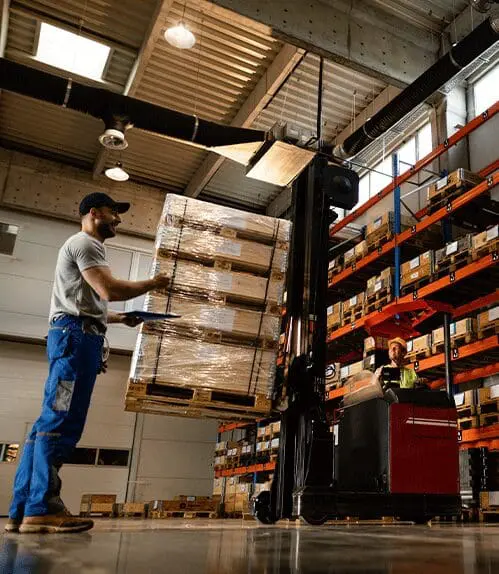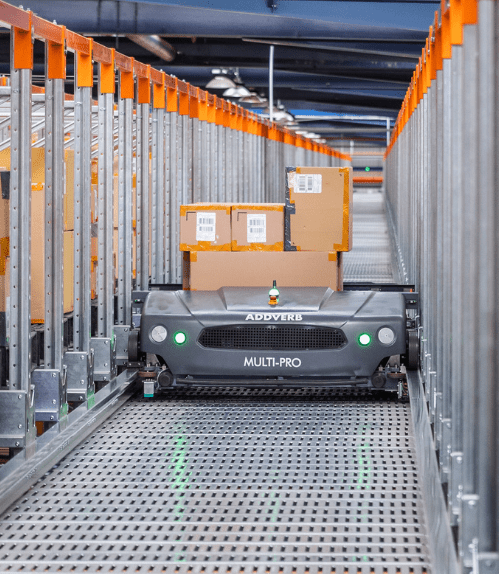Introduction to ASRS
An automated storage and retrieval system (ASRS) is a computer-controlled system that automatically stores and retrieves items from specific locations within a warehouse. It is frequently utilized in distribution centers and manufacturing facilities to handle inventory and lower labor expenses effectively. ASRS usually utilizes automated storage and retrieval machines (AS/RS machines) and can greatly enhance inventory management and order fulfillment processes.
Automated storage and Retrieval Systems enable businesses involved in order fulfilment and warehousing operations to automate their material and inventory handling functions. But there is never a one size fits all. The ASRS solutions available in the market can handle different types, volumes, and throughput of inventory at variable speeds to ensure varying seasonal demand for efficient material handling.
Discover the Crane ASRS by Addverb, which is an innovative solution that enhances efficiency in warehouse automation.
Types of ASRS
Load-based Automated storage and retrieval system
Unit-Load ASRS
Automated Storage and Retrieval Systems (AS/RS) are large systems that store pallet loads, capable of handling heavy loads up to 2500 Kgs. They can place these loads on pallets or within a container, accommodating odd-shaped goods. In a crane-based unit load AS/RS, the system comprises one or more narrow aisles of storage rack structures designed for pallet racking. The structure can reach up to a height of 30 meters, suitable for a typical warehouse.
The storage and retrieval machine (SRM) travels between the racking in two dimensions, guided by software that determines the placement of items in each location. Usually, the system contains one SRM per aisle. However, in a high throughput system, multiple SRMs can be dedicated to a single aisle, while in a slower system, one SRM can be allocated to multiple aisles.
Mini-load ASRS
Mini-load ASRS systems are smaller in size and are used to store items in totes, trays, or cartons weighing less than 50kg. Similar to unit loaders, mini-load ASRS systems generally consist of two aisles of narrow racking structures, with an SRM moving in two dimensions between them. One of the main advantages of mini-load ASRS is its modularity. The system’s height can vary from 8 to 12 meters, depending on the specific requirements and available space.
Micro-load stocker ASRS
Micro-load ASRSs are self-contained structures that densely store products in bins. These products are stored and retrieved by an extractor and then delivered to the operator at a pick face. The pick face of a micro-load stocker often uses a conveyor to bring a queue of items. There are different systems of micro-load stockers available in the market, and each model performs the storage and retrieval operation distinctly.
Micro-load stockers are typically integrated with other ASRS systems, which serve to buffer and stage items, reducing the need for conveyors in the warehouse and increasing the available floor space. This system is especially suited for industries where picking and kitting operations require fast throughput.
Bot-based Automated storage and retrieval system
Shuttle based ASRS
The shuttle-based ASRS technology can be used for both FIFO (first in, first out) and LIFO (last in, first out) configurations, as well as deep-lane or shallow-lane storage structures. There are various types of shuttle-based systems available in the market, depending on factors such as shape, load, size, and the nature of inventory. In this system, an SRM (shuttle or small robot) moves from the workstation to the racking where items are stored when an item is requested. It retrieves the item and travels back to the workstation. In other systems, manual labor and conveyors are used to move items from the racking to the workstations.
For warehouses with low ceilings or other space restrictions for example cold storage, this type of ASRS solutions is the most suitable choice.
Explore Addverb’s cutting-edge automation solution at ITC Limited’s newest distribution center, featuring an advanced ASRS spanning G+3 floors.
Floor Robots ASRS
Why go to the storage area when the storage area can come to you? Floor robots are self-mobile ASRS solutions that store inventory on a portable storage shelving structure. This structure can be retrieved and transported to the area where the operator needs it and can be moved across the facility using AMRs. The structure returns to its allocated space once the operator selects the required item.
This solution is suitable for slow to medium-moving inventory and is scalable as the operation can be easily expanded by increasing the number of AMRs in the system. The standard weight capacity for this solution is 500 kgs per shelving system.
Carousel based Automated storage and retrieval system
Vertical Carousel
The vertical carousel consists of a series of carriers attached to a chain, which travels in a vertical loop around a track, similar to a Ferris wheel. This system is best suited for slow to medium speed inventory movement. When instructed by the operator, the items are efficiently and swiftly delivered to the ergonomically positioned workstation. While manufacturers may introduce new features to the system, the core concept of the technology remains constant.
The system can be easily expanded by incorporating light or voice-based picking technology, which allows for the simultaneous picking of multiple orders. With a typical capacity of 750kg per carrier, the vertical carousel is a cost-effective and dependable solution.
Horizontal Carousel
The horizontal carousel is a high-density storage structure where bins are mounted on an oval track that rotates horizontally to perform storage and retrieval functions. This solution is designed for storing slow and medium-moving inventory and can handle items and cases weighing up to 100kg. The structure is often installed in groups called pods to maximize speed and achieve high throughput.
Additionally, the solution can be scaled up with the addition of light or voice-based picking technology, enabling the picking of multiple orders simultaneously. The structure is also equipped with an automated door system, creating an enclosed solution. Overall, this system allows for excellent space utilization and high storage density.
Miscellaneous
Vertical lift module ASRS
Vertical Lift Modules (VLMs) are essential in supply chain systems. They are best suited for facilities with high ceilings, up to 100 feet, and heavy items that need assistance to be handled safely.
Experience the incredible transformation in warehouse efficiency as Addverb’s Vertical Lift ASRS revolutionizes operations at PepsiCo.
VLMs consist of two columns of trays facing each other, with a mechanical extractor between them. Similar to an elevator, the extractor moves up and down automatically to retrieve and store items from the trays. In warehouses, inventory is stored in these columns, and using the control pad, the extractor can intelligently detect and retrieve items by entering the tray number. This operation applies to both extraction and replenishment of materials in the vertical storage module.
Automated Storage and Retrieval Systems (ASRSs) are crucial equipment in warehouses. They provide significant value in various sectors, especially in Food & Beverages, Consumer Goods, Pharma, Dairy, Cold Storage, and Metals. These systems serve as the primary means of storing and retrieving products, and handling loads of small parts or large, multi-ton units, depending on the system.
Discover the fascinating world of warehouse automation! Dive into our latest blog posts for more in-depth insights.
Conclusion
Automated Storage and Retrieval Systems (ASRS) have transformed the logistics industry by improving efficiency, accuracy, and space utilization. ASRS includes unit-load and mini-load systems, carousel-based systems, vertical lift modules, and shuttle systems, each offering unique features for different applications. These technologies are essential for modern logistics in manufacturing, distribution, and retail industries, ensuring optimal inventory management and efficient order fulfillment processes.
By selecting and implementing the right ASRS solutions, businesses can make significant improvements in their warehousing and material handling operations.
FAQ
What is ASRS?
An AS/RS is a type of warehouse technology that automates the process of storing and retrieving goods. It uses various automated systems such as shuttles, cranes, carousels, and robots to manage inventory with precision and efficiency.
What are the benefits of using an ASRS?
- Increased efficiency: Faster retrieval and storage of items.
- Space optimization: Better use of vertical space.
- Labor reduction: Decreases the need for manual labor.
- Accuracy: Reduces human error in inventory management.
- Safety: Enhances workplace safety by minimizing manual handling.
How does an ASRS work?
An AS/RS uses a combination of automated machinery and software. The system’s software manages inventory data and directs the automated machinery to store or retrieve items based on this information.
What industries benefit most from Automated Storage and Retrival System?
- Manufacturing: For efficient parts storage and retrieval.
- Retail: For managing inventory in distribution centers.
- Pharmaceuticals: For precise storage and retrieval of medical supplies.
- Food and Beverage: For handling temperature-sensitive goods.
- E-commerce: For fast order fulfillment.
What factors should be considered when implementing an AS/RS?
- Inventory characteristics: Size, weight, and type of items.
- Throughput requirements: Speed and frequency of retrieval and storage.
- Space constraints: Available vertical and horizontal space.
- Integration needs: Compatibility with existing systems (WMS/ERP).
- Budget: Initial investment and maintenance costs.
What are the maintenance requirements for an AS/RS?
Regular maintenance includes software updates, mechanical inspections, cleaning, and servicing of moving parts. Predictive maintenance using sensors and data analytics can help in early detection of potential issues.
Can an AS/RS be customized?
Yes, AS/RS solutions can be tailored to meet specific business needs, including custom configurations for storage density, load handling, and integration with other automation systems.
What is the typical cost of an AS/RS?
Costs vary widely based on system complexity, size, and capabilities. Initial investments can range from a few hundred thousand to several million dollars, with ongoing operational and maintenance costs.
How long does it take to implement an AS/RS?
Implementation time can vary from several months to over a year, depending on the system complexity, customization requirements, and scale of the project.
